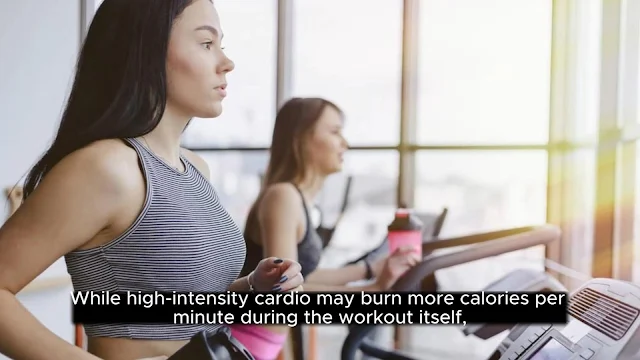Cardio Exercises - Low or High Intensity: Which Burns Body Fat Faster?
Cardiovascular exercises, commonly known as cardio, play a crucial role in maintaining overall fitness and burning excess body fat. However, there's a perpetual debate about whether low-intensity or high-intensity cardio workouts are more effective in burning fat efficiently. Let’s delve into this discussion and uncover the truth behind the intensity levels in cardio exercises.
Understanding Intensity in Cardio Workouts
Differentiating Between Low and High Intensity
Cardio exercises are broadly categorized based on the level of intensity they require. Low-intensity cardio typically involves activities like walking, leisure cycling, or gentle swimming, where the heart rate remains relatively low. On the other hand, high-intensity cardio involves activities like sprinting, interval training, or vigorous cycling, pushing the heart rate to higher levels for shorter durations.
Impact of Intensity on Fat Burning
Metabolic Effects of Low-Intensity Cardio
Low-intensity cardio primarily relies on fat as the primary fuel source during the workout. Since the intensity is low, the body can sustain the activity for longer durations, making it ideal for beginners or those with certain health conditions. While it may not result in immediate calorie burn as high-intensity workouts, it can still contribute significantly to overall fat loss when performed consistently over time.
Metabolic Effects of High-Intensity Cardio
High-intensity cardio, on the other hand, triggers a phenomenon known as Excess Post-Exercise Oxygen Consumption (EPOC) or the afterburn effect. This means the body continues to burn calories at an elevated rate even after the workout, contributing to greater fat loss in a shorter time frame. High-intensity cardio also helps in preserving lean muscle mass, which is crucial for maintaining a healthy metabolism.
Comparative Analysis
Efficiency in Fat Burning
While high-intensity cardio may burn more calories per minute during the workout itself, the overall efficiency in fat burning depends on various factors like individual fitness levels, duration, and consistency. Both low and high-intensity cardio can be effective for fat loss when incorporated into a well-rounded fitness routine.
Time Investment
High-intensity cardio workouts are typically shorter in duration compared to low-intensity sessions due to their higher intensity levels. This makes them a preferred choice for individuals with busy schedules who seek efficient workouts with maximum benefits in minimal time.
Sustainable Practices
Sustainability is key when it comes to long-term fitness goals. While high-intensity cardio can yield quick results, it may not be sustainable for everyone due to its demanding nature. Low-intensity cardio, on the other hand, offers a more sustainable approach that can be easily integrated into daily routines without excessive strain on the body.
Benefits Beyond Fat Burning
Apart from fat loss, both low and high-intensity cardio offer numerous health benefits. They improve cardiovascular health, boost mood, increase energy levels, and enhance overall well-being. Choosing the right intensity level depends on individual goals, preferences, and fitness levels.
Choosing the Right Intensity
Individual Fitness Levels
It's essential to consider individual fitness levels and health conditions when choosing the intensity of cardio workouts. Beginners or those with certain health concerns may benefit from starting with low-intensity cardio and gradually progressing to higher intensities as they build endurance and strength.
Goals and Objectives
The choice between low and high-intensity cardio also depends on specific fitness goals. Those aiming for quick fat loss or improved athletic performance may lean towards high-intensity workouts, while others focusing on overall health and well-being may find low-intensity cardio more suitable.
Variety in Cardio Workouts
Mixing Intensity for Optimal Results
For optimal results, incorporating a mix of low and high-intensity cardio workouts into a weekly exercise routine can be beneficial. This not only prevents boredom but also challenges different muscle groups while maximizing fat-burning potential.
Safety Considerations
Injury Risks
Regardless of the intensity level, safety should always be a priority during cardio workouts. Proper warm-up, cool-down, and using correct form are essential to prevent injuries. It's also advisable to consult with healthcare professionals before starting any new exercise regimen, especially for individuals with pre-existing health conditions.
Case Studies and Success Stories
Real-life examples of individuals who have achieved their fitness goals through various cardio workouts can serve as motivation and inspiration for others. Sharing success stories and case studies can provide valuable insights into the effectiveness of different intensity levels in cardio exercises.
Tips for Effective Cardio Workouts
Warm-up and Cool-down Routines
Before starting any cardio workout, it's crucial to perform a proper warm-up to prepare the body for exercise and prevent injuries. Similarly, incorporating a cool-down routine helps in gradually lowering the heart rate and preventing muscle soreness.
Monitoring Heart Rate
Monitoring heart rate during cardio workouts can help individuals gauge the intensity level and adjust accordingly. Various fitness trackers and wearable devices are available to track heart rate zones and optimize fat-burning potential.
Common Myths Debunked
Myth: High-Intensity is Always Better
While high-intensity cardio has its benefits, it's not always the best option for everyone. Low-intensity cardio can be equally effective, especially for beginners or those with specific health concerns.
Myth: Low-Intensity Doesn’t Yield Results
Contrary to popular belief, low-intensity cardio can yield significant results when performed consistently over time. It may not burn as many calories as high-intensity workouts, but it still contributes to overall fat loss and improved fitness levels.
Conclusion
In conclusion, both low and high-intensity cardio exercises have their place in a well-rounded fitness routine. The choice between the two depends on individual goals, preferences,

Post a Comment